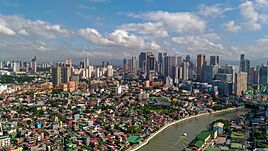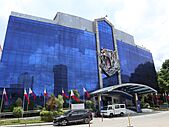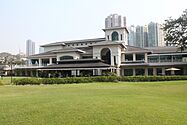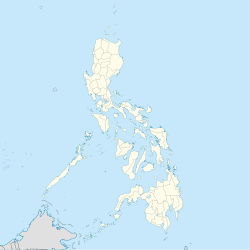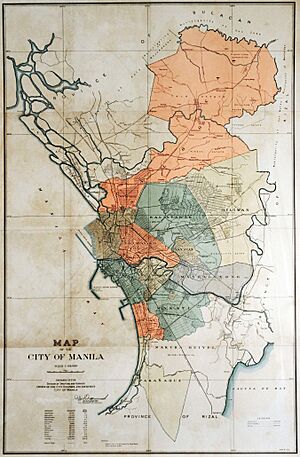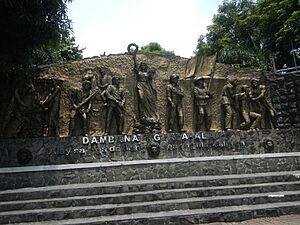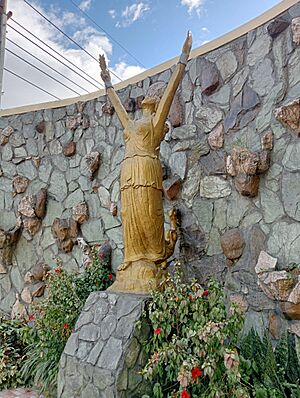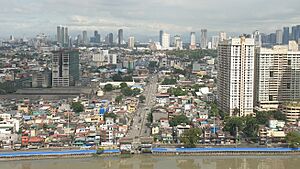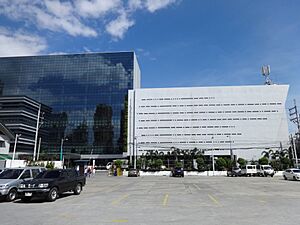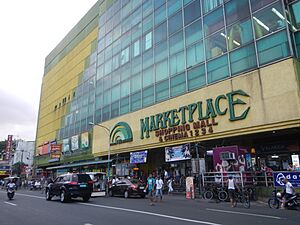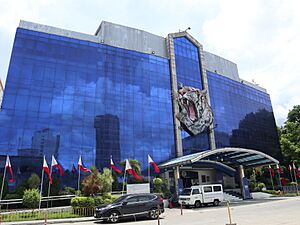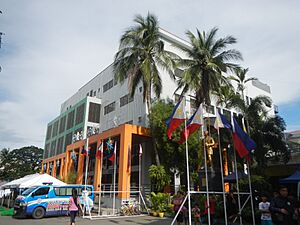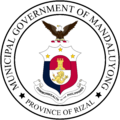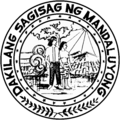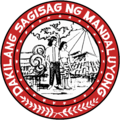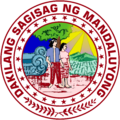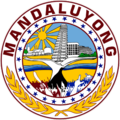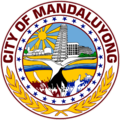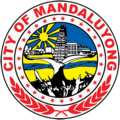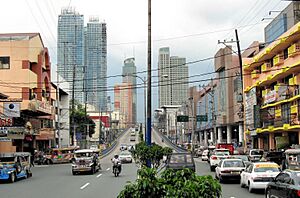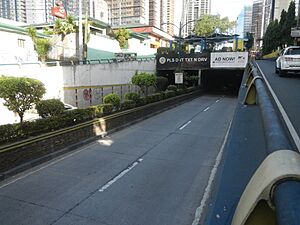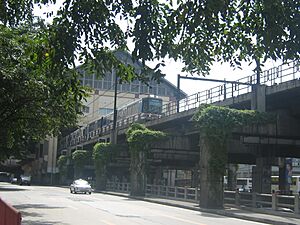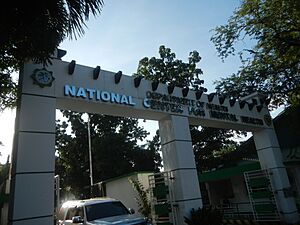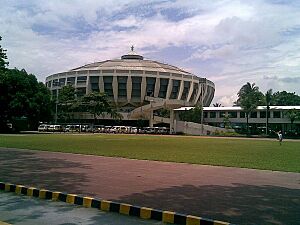Mandaluyong facts for kids
Quick facts for kids
Mandaluyong
San Felipe de Mandaloyón
|
|||
|---|---|---|---|
|
Highly urbanized city
|
|||
|
Aerial view of Mandaluyong
Welcome Monument
Mandaluyong City Hall
San Felipe Neri Parish Church
National Center for Mental Health
SMC Headquarters
SM Megamall
BDO Corporate Center
Wack Wack Golf and Country Club
|
|||
|
|||
| Nickname(s):
Tiger City of the Philippines, Shopping Capital of the Philippines
|
|||
| Motto(s):
Gawa, hindi salita!
English: "Action, not words!" |
|||
| Anthem: Martsa ng Mandaluyong English: Mandaluyong March |
|||
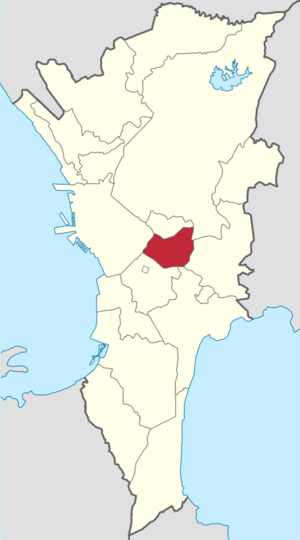
Map of Metro Manila with Mandaluyong highlighted
|
|||
|
OpenStreetMap
|
|||
| Country | |||
| Region | National Capital Region | ||
| District | [[{{#property:P7938}} | — Lua error in Module:Wd at line 1804: attempt to index field 'wikibase' (a nil value).]] | ||
| Founded | 1841 | ||
| Chartered | March 27, 1907 | ||
| Renamed | November 6, 1931 (as Mandaluyong) | ||
| Cityhood and HUC | February 9, 1994 | ||
| Former Old Name | San Felipe Neri | ||
| Barangays | 27 (see Barangays) | ||
| Government
|
|||
| • Type | Sangguniang Panlungsod | ||
| Area | |||
| • Total | 11.26 km2 (4.35 sq mi) | ||
| Elevation | 32 m (105 ft) | ||
| Highest elevation | 592 m (1,942 ft) | ||
| Lowest elevation | -2 m (−6.6 ft) | ||
| Population
(2020 census)
|
|||
| • Total | 425,758 | ||
| • Density | 37,812/km2 (97,930/sq mi) | ||
| • Households | 116,954 | ||
| Demonym(s) | Mandaleño | ||
| Economy | |||
| • Income class | 1st city income class | ||
| • Poverty incidence |
|
||
| • Revenue | ₱ 6,226 million (2022) | ||
| • Assets | ₱ 31,935 million (2022) | ||
| • Expenditure | ₱ 5,638 million (2022) | ||
| Service provider | |||
| • Electricity | Manila Electric Company (Meralco) | ||
| Time zone | UTC+8 (PST) | ||
| PSGC |
[https://psa.gov.ph/classification/psgc/?q=psgc/barangays/{{#pro000®code={{&provcode=
|
||
| IDD : area code | +63 (0)02 | ||
| Native languages | Tagalog | ||
| Major religions | Roman Catholic | ||
| Feast date | May 26 | ||
| Catholic diocese | Roman Catholic Archdiocese of Manila | ||
| Patron saint | Saint Philip Neri Immaculate Conception | ||
| Website | mandaluyong |
||
Mandaluyong (![]() i/məndɑːˈlujɒŋ/ MƏN-dah-LOO-yong; Tagalog pronunciation: [mɐndɐˈlujoŋ]), officially called the City of Mandaluyong (Filipino: Lungsod ng Mandaluyong, [luŋˈsod nɐŋ mɐndɐˈlujoŋ]), is a busy city in the National Capital Region of the Philippines. It is a highly urbanized city, meaning it is a very developed area with a large population. In 2020, about 425,758 people lived here.
i/məndɑːˈlujɒŋ/ MƏN-dah-LOO-yong; Tagalog pronunciation: [mɐndɐˈlujoŋ]), officially called the City of Mandaluyong (Filipino: Lungsod ng Mandaluyong, [luŋˈsod nɐŋ mɐndɐˈlujoŋ]), is a busy city in the National Capital Region of the Philippines. It is a highly urbanized city, meaning it is a very developed area with a large population. In 2020, about 425,758 people lived here.
Mandaluyong is located just east of Manila. It was once a small part of Santa Ana de Sapa (now a district of Manila) and was known as San Felipe Neri. It became its own town in 1841. Later, during the American occupation, its name changed to Mandaluyong in 1931. In 1994, it became the first town in Metro Manila to be officially called a city since Metro Manila was formed in 1975.
Today, Mandaluyong is famous for the Ortigas Center, a big area for businesses and shopping that it shares with Pasig City. Important places in Mandaluyong include the Asian Development Bank, the main offices of Banco de Oro and San Miguel Corporation, and popular shopping malls like Shangri-La Plaza and SM Megamall.
The city is surrounded by other cities: Manila to the west, San Juan to the north, Quezon City to the northeast, Pasig to the east, Taguig to the southeast, and Makati to the south. Mandaluyong is one of the smallest cities in the Philippines, covering about 11.26 square kilometers.
Contents
- What's in a Name? The Story of Mandaluyong
- Mandaluyong's Journey Through Time
- Mandaluyong's Location and Climate
- People of Mandaluyong
- Mandaluyong's Economy
- How Mandaluyong is Governed
- Getting Around Mandaluyong
- Healthcare in Mandaluyong
- Learning in Mandaluyong
- International Connections
- Notable People from Mandaluyong
- See also
What's in a Name? The Story of Mandaluyong
There are a few interesting stories about how Mandaluyong got its name.
One story says the area had many luyong trees, which are now known as anahaw trees. People used these trees to make canes and furniture.
Another story comes from a Spanish navigator named Acapulco. He saw the rolling hills of the area being hit by daluyong, which means "big waves from the sea." This matches old stories that giant waves used to crash against the hills in the lowlands. A historian named Felix dela Huerta also noticed that the land looked like big sea waves. When foreigners asked what the place was called, locals would describe it as "madaluyong" (meaning "wavy" or "undulating"). Spanish writers later wrote this as "Mandaluyong."
A different legend tells of a Maharlika (a noble person) named Luyong who fell in love with Manda, the beautiful daughter of a local leader. The leader didn't approve of Luyong at first. But Luyong won Manda's hand by winning several tribal contests, as was the tradition. The couple then settled in a place that was later named “Mandaluyong,” combining their names.
Mandaluyong's Journey Through Time
Early Beginnings
The first people of Mandaluyong are believed to be connected to Emperor Soledan and Empress Sasaban of the ancient Kingdom of Sapa, around the year 1300. This kingdom grew and became the "Kingdom of Namayan" by 1470. It was a large kingdom that included parts of what are now Manila, Mandaluyong, San Juan, Makati, Pasay, Pateros, Taguig, and Parañaque.
Spanish Colonial Period
How Mandaluyong Was Founded
Mandaluyong was first a barrio (a small village) of Santa Ana de Sapa. The Spaniards named it San Felipe Neri to honor the patron saint of Rome. In 1841, it became a separate town.
On September 15, 1863, San Felipe Neri got its own church parish. The church and school built there became important places for spreading the ideas of the Katipunan during the 1896–1898 Revolution.
Old Barangays and the Revolution
In 1829, Mandaloyon had 10 barangays, each named after saints. By 1845, when it became a separate town, it had 17 barangays. Later, in the 1880s, the practice of naming barangays after saints stopped, and the number of barrios (villages) was reduced to ten.
Mandaluyong played a big role in the Philippine Revolution of 1896. It was a key area for the Katipunan group, which had seventeen branches here. On August 29, 1896, Andres Bonifacio, a leader of the Katipunan, met with others in Sitio Balakbak (now Villa San Miguel) to plan the revolution against Spain. It was in Barangay Hagdang Bato on August 28, 1896, that Bonifacio announced the attack on Manila for August 29, 1896.
After a successful revolution in San Felipe Neri on August 30, 1896, the Katipuneros went to San Juan del Monte. They attacked the El Polvorin (gunpowder depot) to get more weapons. This event is known as the Battle of San Juan del Monte. The revolutionary newspaper, La Republika, was also started in this town on September 15, 1896.
American Colonial Period
On June 11, 1901, San Felipe Neri became part of the new Rizal province. During the American Occupation, it became a first-class municipality with five main barrios. For a few months in 1904, San Felipe Neri was even the capital of Rizal. On March 27, 1907, San Juan del Monte separated from San Felipe Neri to become its own town again.
San Felipe Neri was officially renamed Mandaluyong on November 6, 1931. During this time, many important government buildings were built, including the Correctional Institute for Women, Welfareville Compound, The Boy's Town, and the National Center for Mental Health.
Japanese Occupation Era
From 1942 to 1945, during World War II, Mandaluyong was part of the City of Greater Manila. Many people in Mandaluyong lost their lives during the war. The city suffered a lot of damage. However, on February 9, 1945, American and Philippine Commonwealth troops arrived, saving the municipality from more destruction. This day is celebrated as Mandaluyong's liberation from the Japanese forces.
After Philippine Independence
After World War II, Mandaluyong began to grow and its economy improved greatly. Many new buildings, companies, and businesses were developed in the 1950s and 1960s. This made Mandaluyong known as one of the most developed municipalities in Rizal province.
The Martial Law Era
Mandaluyong was mentioned during the time President Ferdinand Marcos declared Martial Law. An event, sometimes called the 1972 ambush of Juan Ponce Enrile, happened in Wack Wack, an exclusive area in Mandaluyong, just before Martial Law was put into effect. This event was used to help explain why Martial Law was needed.
Business Growth and Changes
Before Martial Law, a successful businessman named Domingo M. Guevara Sr. had his company, Radiowealth, in Mandaluyong. His company made affordable Philippine-made appliances. Later, it grew into Guevara Enterprises, which was big in electronics, transportation, and manufacturing. However, his businesses faced difficulties when he did not agree to give control of his companies to President Ferdinand Marcos during Martial Law.
Becoming Part of Metro Manila
On November 7, 1975, Mandaluyong officially became part of the new Metro Manila area. This was done by a special order signed by President Ferdinand Marcos.
Becoming a City
In 1994, a law was passed to make Mandaluyong a highly urbanized city. President Fidel V. Ramos signed this law on February 9, 1994. The people of Mandaluyong voted to approve this change on April 10, 1994. This made Mandaluyong the fifth city in Metro Manila. After this, Mandaluyong got its own representative in Congress.
Mandaluyong Today
Today, Mandaluyong has 27 barangays, which are like small districts. These are divided into two main political areas. In 2002, Mandaluyong was called "The Tiger City of the Philippines" because its economy had improved so much.
Mandaluyong's Location and Climate
Geography
Mandaluyong is shaped like a heart and covers about 11.26 square kilometers. It is about 7 kilometers southeast of Manila and 8 kilometers west of Pasig. To the south, it is separated from Makati and Taguig by the Pasig River. To the northwest is San Juan, and to the northeast is Quezon City. This means Mandaluyong is right in the middle of Metro Manila.
Barangays
Mandaluyong is divided into 27 barangays or local communities.
Climate
Mandaluyong has a tropical climate. This means it's usually warm all year round. There is much less rain in winter than in summer. The average temperature is about 27.2 degrees Celsius. The city gets about 2093 millimeters of rain each year. The driest month is February, with only about 8 millimeters of rain. August is the wettest month, with about 448 millimeters of rain. May is the hottest month, averaging 29.2 degrees Celsius, while January is the coolest, at about 25.5 degrees Celsius.
| Climate data for Mandaluyong | |||||||||||||
|---|---|---|---|---|---|---|---|---|---|---|---|---|---|
| Month | Jan | Feb | Mar | Apr | May | Jun | Jul | Aug | Sep | Oct | Nov | Dec | Year |
| Mean daily maximum °C (°F) | 29.7 (85.5) |
30.5 (86.9) |
32.1 (89.8) |
33.7 (92.7) |
33.8 (92.8) |
32.3 (90.1) |
31.1 (88.0) |
30.6 (87.1) |
30.7 (87.3) |
30.9 (87.6) |
30.4 (86.7) |
29.7 (85.5) |
31.3 (88.3) |
| Daily mean °C (°F) | 25.5 (77.9) |
25.9 (78.6) |
27.2 (81.0) |
28.7 (83.7) |
29.2 (84.6) |
28.4 (83.1) |
27.6 (81.7) |
27.3 (81.1) |
27.2 (81.0) |
27.2 (81.0) |
26.7 (80.1) |
25.9 (78.6) |
27.2 (81.0) |
| Mean daily minimum °C (°F) | 21.3 (70.3) |
21.4 (70.5) |
22.4 (72.3) |
23.8 (74.8) |
24.7 (76.5) |
24.5 (76.1) |
24.1 (75.4) |
24.0 (75.2) |
23.8 (74.8) |
23.5 (74.3) |
23.0 (73.4) |
22.1 (71.8) |
23.2 (73.8) |
| Average precipitation mm (inches) | 13.5 (0.53) |
7.3 (0.29) |
21.4 (0.84) |
18.7 (0.74) |
138.6 (5.46) |
283.8 (11.17) |
364.1 (14.33) |
476.3 (18.75) |
334.1 (13.15) |
200.5 (7.89) |
111.4 (4.39) |
56.0 (2.20) |
2,025.7 (79.74) |
| Average rainy days (≥ 0.10 mm) | 4 | 2 | 3 | 3 | 10 | 16 | 22 | 22 | 20 | 18 | 14 | 9 | 143 |
| Average relative humidity (%) | 72 | 73 | 66 | 64 | 68 | 76 | 80 | 83 | 81 | 78 | 76 | 75 | 74 |
| Mean monthly sunshine hours | 176.7 | 197.8 | 225.8 | 258.0 | 222.7 | 162.0 | 132.8 | 132.8 | 132.0 | 157.6 | 153.0 | 151.9 | 2,103.1 |
| Percent possible sunshine | 51 | 61 | 61 | 70 | 57 | 42 | 34 | 34 | 36 | 44 | 45 | 44 | 48 |
| Source 1: Climate-Data.org (Temperature) | |||||||||||||
| Source 2: Climatemps.com (Sunshine) | |||||||||||||
People of Mandaluyong
In 2020, Mandaluyong had 425,758 residents. This means there were about 45,830 people living in every square kilometer. People from Mandaluyong are called "Mandaleños." Most of them are Filipinos from different ethnic backgrounds.
Most people in Mandaluyong are Roman Catholic. There are also other religious groups, like the Iglesia ni Cristo, Evangelical Christianity, Protestantism, Jehovah’s Witness, and Philippine Independent Church.
Mandaluyong's Economy
|
||||
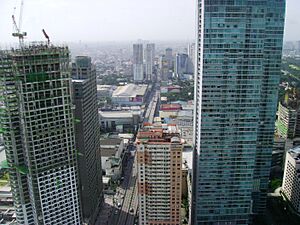
Mandaluyong is a busy city with many shopping centers, places for entertainment, businesses, tall office buildings, homes, and hotels. It is one of the most important business and financial areas in Metro Manila.
Shopping and Business Areas
Like other cities in Metro Manila, Mandaluyong has its own business areas. These areas have many banks, offices, and service shops. They are located along public transport routes, serving both local people and those passing through.
Major business streets include Boni Avenue, Shaw Boulevard, and the EDSA-Shaw-Pioneer area. This area includes the Greenfield District, which is a growing development.
Industries and Companies
Most of the industrial activities are found near Shaw Boulevard-Pioneer area and along the Pasig River. While Mandaluyong used to be known for making food, medicines, and lab equipment, many of these factories are now moving to new industrial zones outside Metro Manila. Areas along the Pasig River that were once industrial are now being used for homes. The EDSA-Shaw-Pioneer area is changing to focus more on commercial activities that are competitive globally.
Since December 2013, Mandaluyong has been home to TV5, one of the largest television networks in the country. It also hosts Cignal TV, a big pay TV operator. Both are owned by PLDT-backed MediaQuest Holdings. The TV5 Media Center also serves as the main broadcast facility for CNN Philippines' successor, RPTV. Other media companies, like Solar Entertainment Corporation, also have facilities here.
Shopping Centers
Mandaluyong has many large shopping malls. These malls have hundreds of local and international stores, department stores, and supermarkets. They offer not just shops but also movie theaters, rides, skating rinks, and bowling alleys. These malls have thousands of parking spaces and are often near train stations and business districts. They serve people from Metro Manila, nearby areas, and even tourists. Some of the malls in the city are Shangri-La Plaza, SM Megamall, The Podium, St. Francis Square, Starmall EDSA-Shaw, SM Cherry Shaw, The Marketplace Shopping Mall, and Shaw Center Mall. The Greenfield District also has four strip malls.
The first branch of the supermarket chain Puregold opened in Shaw, Mandaluyong, in 1998.
How Mandaluyong is Governed
Mandaluyong is led by a mayor, a vice mayor, and city councilors. These officials work together to manage the city and make decisions for its residents.
Current City Officials
| Position | Candidate | Party | |
|---|---|---|---|
| Representative Lone Legislative District |
Alexandria P. Gonzales | NUP | |
| Mayor | Carmelita Abalos | PFP | |
| Vice Mayor | Antonio D. Suva Jr. | PFP | |
| City Councilors | |||
| 1st Councilor District | |||
| Charisse Marie A. Abalos-Vargas | PFP | ||
| Anjelo Elton P. Yap | PFP | ||
| Danilo L. De Guzman | PFP | ||
| Carissa Mariz S. Manalo | PFP | ||
| Grace Marie V. Antonio | PFP | ||
| Estanislao V. Alim III | PFP | ||
| 2nd Councilor District | |||
| Benjamin A. Abalos III | PFP | ||
| Alexander C. Sta. Maria | PFP | ||
| Michael Eric G. Cuejilo | PFP | ||
| Fernando S. Ocampo | PFP | ||
| Reginald S. Antiojo | PFP | ||
| Leslie F. Cruz | PFP | ||
| ABC President | Darwin Fernandez | ||
| SK President | Aeron Sedrick Mangaliag | ||
Past Mayors of Mandaluyong
Here are some of the people who have served as mayors (or municipal presidents) of Mandaluyong over the years:
| # | Mayor | Dates in Office | Notes |
|---|---|---|---|
| 1 | Buenaventura Domingo | 1901 | First municipal president of San Felipe Neri |
| 2 | Dr. Antonio Fernando | 1902 | |
| 3 | Januario Coronado | 1902 | |
| 4 | Miguel Vergara | 1902 | |
| 5 | Pantaleón Blas | 1903 | First Municipal president since the annexation of San Juan del Monte |
| 6 | Claro Castañeda | 1905 | Last Municipal president while San Juan de Monte was part of San Felipe Neri |
| 7 | Apolinar Coronado | 1907–1909 | |
| * | Januario Coronado | 1909–1912 | |
| 8 | Marcelo Lerma | 1912–1916 | |
| 9 | Mariano Castañeda | 1916–1922 | |
| 10 | Clemente Fernando | 1922–1925 | |
| 11 | Gregorio Pedro | 1925–1928 | |
| * | Clemente Fernando | 1928–1934 | First municipal mayor of the renamed Mandaluyong |
| 12 | Isaac López | 1935–1939 | |
| 13 | Ponciano Enriquez | 1940 | |
| 14 | Pedro Cruz | 1941–1944; 1946 | District Chief of Mandaluyong under the City of Greater Manila (1941–1944) |
| 15 | Primo Guzman | 1945 | |
| 16 | Bonifacio Javier | 1946–1955 | |
| * | Pedro Cruz | 1956–1959 | |
| * | Bonifacio Javier | 1960–1962 | |
| 17 | Amado T. Reyes | 1963 | |
| 18 | Melchor T. Arcangel | 1963 | Acting Mayor |
| 19 | Macario Trinidad | 1963 | Acting Mayor |
| 20 | Filemòn Javier | 1964–1971 | |
| 21 | Renato Lòpez | 1972–1980 | |
| 22 | Ernesto Domingo | 1980–1986 | |
| * | Benjamin Abalos Sr. | 1986–1987 | Acting (Officer in Charge) mayor |
| * | Román de los Santos | 1987–1988 | Acting (Officer in Charge) mayor |
| 23 | Benjamin Abalos Sr. | 1988–1998 | First city mayor |
| 24 | Benjamin Abalos Jr. | 1998–2004 | |
| 25 | Neptali Gonzales II | 2004–2007 | |
| * | Benjamin Abalos Jr. | 2007–2016 | |
| 26 | Carmelita Abalos | 2016–2022 | First female mayor |
| * | Benjamin Abalos Sr. | 2022–2025 | |
| * | Carmelita Abalos | 2025–present |
The City Seal of Mandaluyong
Getting Around Mandaluyong
Mandaluyong has good roads that connect it to other cities in Metro Manila. These include major roads like Epifanio de los Santos Avenue (EDSA), Ortigas Avenue, and Shaw Boulevard.
Land Transportation
The city has about 80.93 kilometers of concrete and asphalt roads. This means it has a lot of roads for its size.
EDSA is the main road that runs through Mandaluyong. Other important roads like Ortigas Avenue and Shaw Boulevard connect Mandaluyong to other cities. Boni Avenue and F. Martinez Street are also important routes within the city. The Boni-Pioneer Underpass is a 280-meter long tunnel under EDSA that helps traffic flow smoothly.
Jeepneys are a very common way for people to travel in the city. Tricycles and pedicabs are also important for getting around smaller streets and alleys.
Water Transportation
The Pasig River runs along the southern border of Mandaluyong. This river offers another way to travel, especially for moving goods for businesses along the river. It also provides a faster way for people to get to and from Pasig and Manila. The Pasig River Ferry Service has one station in Mandaluyong.
Train Transportation
The city also has train service through the Manila Metro Rail Transit System Line 3 (MRT-3), which runs along EDSA. Mandaluyong has three MRT-3 stations: Ortigas, Shaw Boulevard, and Boni.
The Philippine National Railways used to serve Mandaluyong. However, that service stopped in 1982 when a bridge over the San Juan River collapsed.
Healthcare in Mandaluyong
Mandaluyong has several hospitals and health centers. These include private hospitals like Dr. Victor R. Potenciano Medical Center and Unciano General Hospital. There is also a government hospital called Mandaluyong City Medical Center. The city is also home to the National Center for Mental Health. Many residents also go to The Medical City in nearby Ortigas Center, Pasig, for their medical needs.
In 2007, the Mandaluyong city government started a program called Project TEACH (Therapy, Education, and Assimilation of Children with Handicap). This program helps children with special needs from families who cannot afford expensive care. Project TEACH offers free occupational therapy, physical therapy, speech therapy, and special education classes.
Learning in Mandaluyong
Mandaluyong has several well-known schools and universities. These include Arellano University – Plaridel Campus, Don Bosco Technical College, José Rizal University, and Rizal Technological University.
Many city officials of Mandaluyong, including the current Mayor, Benjamin Abalos Jr., are graduates of Don Bosco. Other famous alumni from Don Bosco include rapper Francis Magalona and actor Ricky Davao. Graduates of JRU include former President Ramon Magsaysay. Other colleges in the city are Our Lady of Guadalupe Colleges (for Medicine and Nursing), STI and AMA (for Computer Technology), NAMEI Polytechnic Institute (for Marine Sciences), and the International Baptist College.
The city is also home to Lourdes School of Mandaluyong (established 1911), an all-boys school. La Salle Green Hills (established 1959) is a private co-educational school. Saint Pedro Poveda College (established 1960) is an all-girls school. Even though Poveda's official address is Quezon City, part of its campus is in Mandaluyong.
Mandaluyong High School (established 1977) is the oldest public high school in the city. The City of Mandaluyong Science High School (established 1996) is a public science high school. The city has 18 public schools, including primary and secondary schools, all managed by the Department of Education. The Mataas Na Paaralang Neptali A. Gonzales, named after a famous Mandaluyong native, is the largest school in the city and offers the STEM high school program.
International Connections
Diplomatic Missions
Some countries have their permanent offices or embassies in Mandaluyong. These include:
Sister Cities
Mandaluyong has "sister city" relationships with other cities, which means they share cultural and economic ties.
| National |
|---|
|
Notable People from Mandaluyong
- Aljon Mariano (born 1992) - basketball player
- Anicka Castañeda (born 1999) - footballer
- Antonio Cabangon-Chua (1934–2016) - Philippine Ambassador to Laos, entrepreneur
- Benjamin Abalos (born 1934) - former mayor of Mandaluyong, former chairman of the Commission on Elections
- Benjamin Abalos Jr. (born 1962) - former mayor of Mandaluyong, current Secretary of the Interior and Local Government
- Jonathan Clement "JC" Abalos II (born 1994) - politician
- Brigiding (born 1992) – drag performer
- Carmela Tunay (born 1995) - former volleyball player, actress
- Carmelita Abalos (born 1962) - current mayor of Mandaluyong
- Coleen Garcia (born 1992) - actress, host, and model
- Dante Jimenez (1952–2021) - chairman of the Presidential Anti-Corruption Commission
- Elmer Borlongan (born 1967) - painter
- Francis Magalona (1964–2009) - rapper, singer, and songwriter
- Freddy Gonzalez (born 1978) - former football player
- Fyang Smith (born 2006) - social media influencer and model
- Gio Alvarez (born 1976) - actor
- Imee Marcos (born 1955) - current Senator
- Javi Gómez de Liaño (born 1998) - basketball player
- John Raspado (born 1981) - businessman, titleholder of Mr. Gay World 2017
- Johnedel Cardel (born 1970) - head coach, former basketball player
- Juami Tiongson (born 1991) - basketball player
- Kevin Racal (born 1991) - basketball player
- Lance Serrano (born 1992) - actor, model
- Lei Ponce (born 1984) - make-up artist
- Louie Mar Gangcuangco (born 1987) - physician, researcher, and professor
- Manny Victorino (born 1958) - retired basketball player
- Maico Buncio (1988–2011) - motorcycle racer
- Mark Cardona (born 1981) - basketball player
- Marlon Manalo (born 1975) - former pool player
- Michele Bumgarner (born 1989) - racing driver
- Mikey Bustos (born 1981) - YouTuber, vlogger, singer, and comedian
- Neptali Gonzales (1923–2001) - former Senate president
- Neptali Gonzales II (born 1954) - former mayor of Mandaluyong, current representative
- Paul Zamar (born 1987) - basketball player
- Renz Ongkiko (born 1988) - newscaster, model
- Ria Atayde (born 1992) - actress
- Rico Yan (1975–2002) - actor and entrepreneur
- Shehyee (born 1992) - rapper, songwriter
- Sophie Albert (born 1990) - actress
- Troy Rosario (born 1992) - basketball player
See also
 In Spanish: Mandalúyong para niños
In Spanish: Mandalúyong para niños
- List of renamed cities and municipalities of the Philippines


